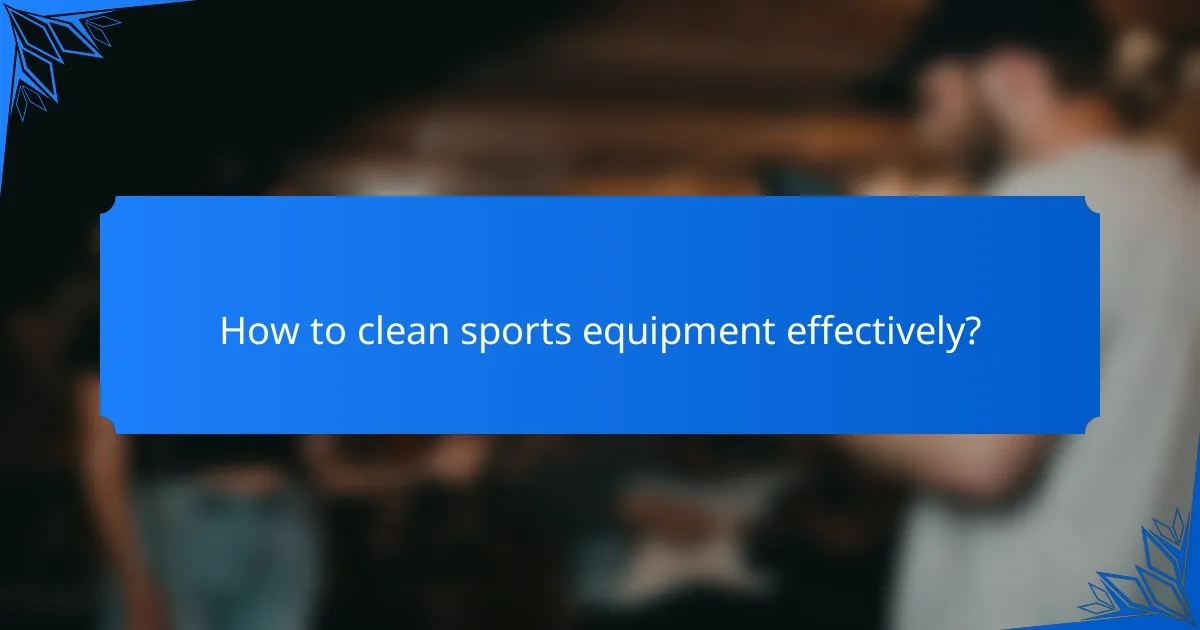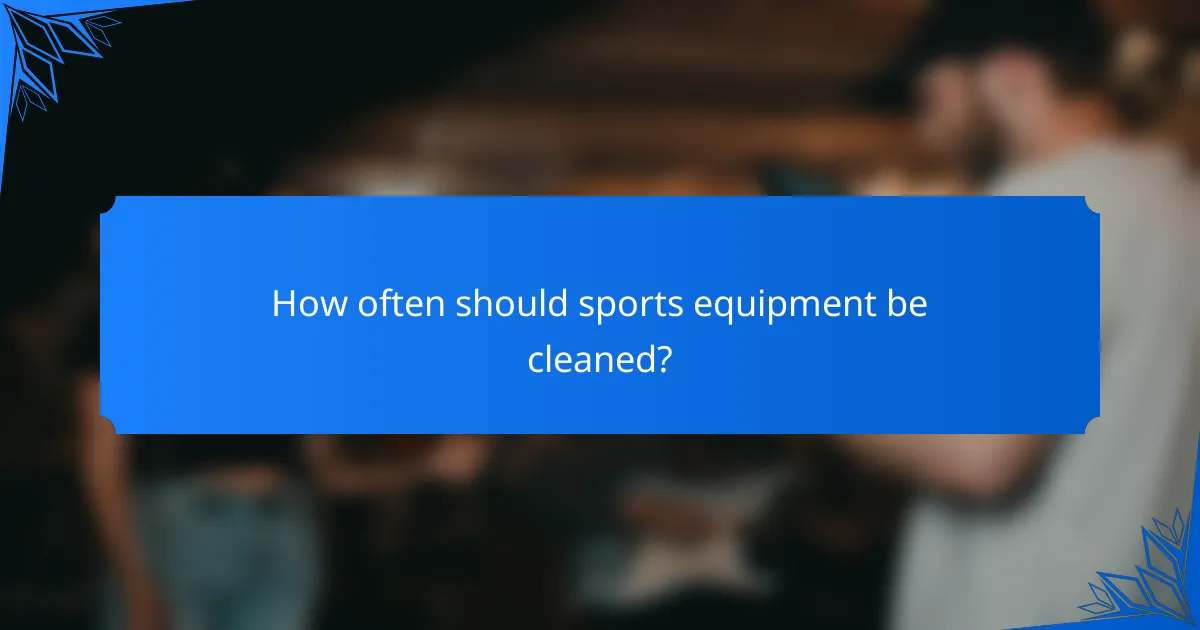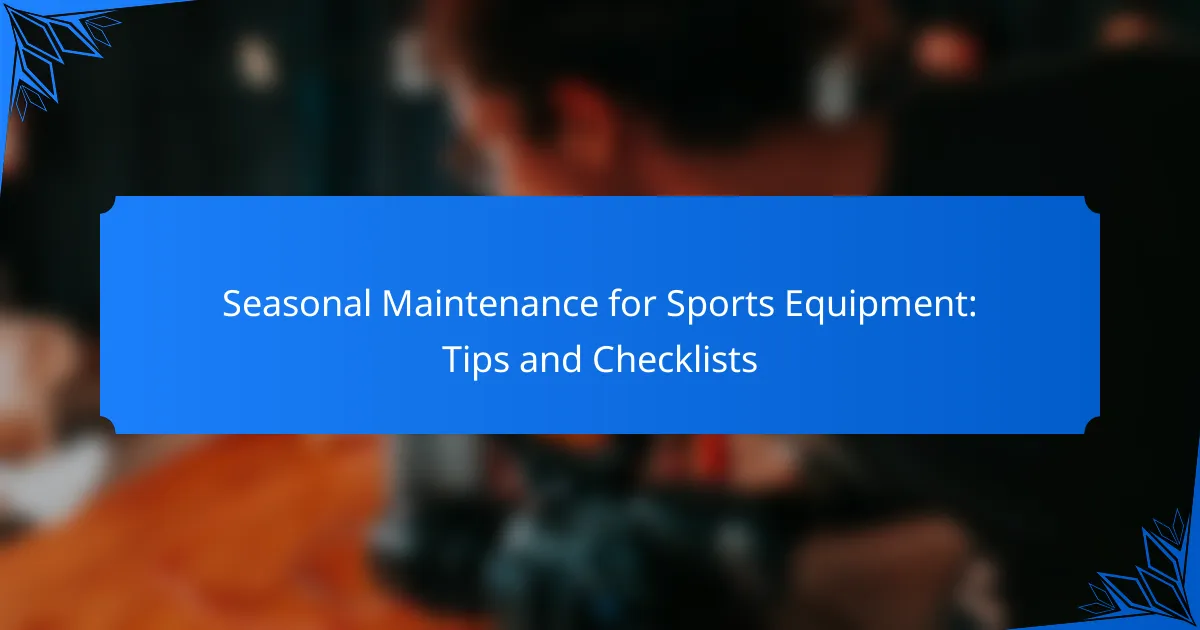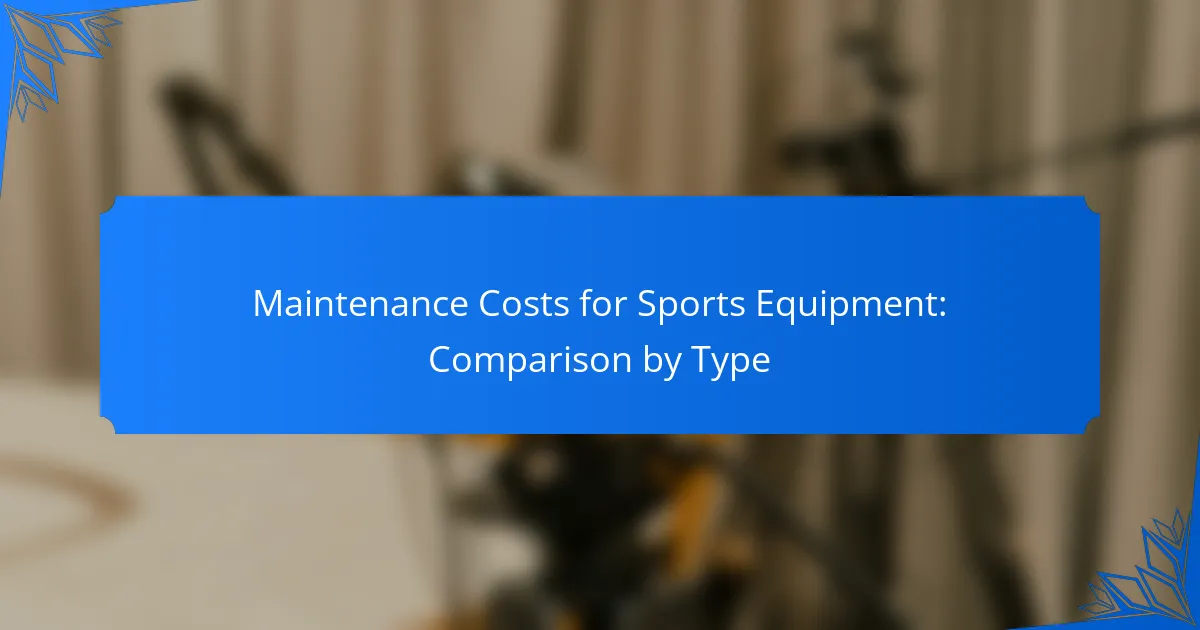Cleaning and storing sports equipment is essential for maintaining hygiene and prolonging the lifespan of your gear. By using the right cleaning methods and products, you can effectively remove dirt, sweat, and bacteria, ensuring your equipment remains safe and functional. Additionally, proper storage techniques in a clean, organized, and climate-controlled environment can further enhance the performance and durability of your sports gear.

How to clean sports equipment effectively?
Cleaning sports equipment effectively involves using the right cleaning methods and products to maintain hygiene and prolong the lifespan of the gear. Regular cleaning helps remove dirt, sweat, and bacteria, ensuring that your equipment remains safe and functional.
Use mild soap and water for general cleaning
Mild soap and water are suitable for most types of sports equipment, including balls, pads, and helmets. Mix a small amount of soap with warm water and use a soft cloth or sponge to gently scrub the surfaces.
Rinse thoroughly with clean water to remove any soap residue, which can attract dirt if left behind. This method is effective for routine maintenance and can be done after every few uses.
Utilize specialized cleaners for specific materials
Different materials require tailored cleaning solutions. For instance, synthetic fabrics may benefit from a specialized sports detergent, while leather equipment needs a cleaner designed specifically for leather care.
Always check the labels for compatibility with your equipment. Using the wrong cleaner can damage the material or reduce its performance, so it’s wise to invest in products that match your gear’s specific needs.
Employ disinfectant wipes for high-touch areas
High-touch areas, such as grips, straps, and handles, should be cleaned frequently to prevent the spread of germs. Disinfectant wipes are convenient for this purpose, as they can quickly sanitize surfaces without the need for additional water or drying time.
Make sure the wipes are suitable for the material of your equipment to avoid any damage. Regularly wiping down these areas after use can significantly reduce the risk of infections.
Follow manufacturer guidelines for cleaning
Always refer to the manufacturer’s cleaning instructions for your sports equipment. These guidelines provide specific recommendations on the best cleaning methods and products to use, ensuring you do not void any warranties.
Adhering to these guidelines can help maintain the integrity and performance of your gear, as manufacturers often test their products under specific conditions and know the best care practices.

What are the best practices for storing sports equipment?
To effectively store sports equipment, prioritize a clean, organized, and climate-controlled environment. Proper storage techniques can extend the lifespan of your gear and maintain its performance.
Store in a cool, dry place to prevent damage
Storing sports equipment in a cool, dry environment is crucial to prevent moisture-related damage and deterioration. Aim for a temperature range of 15-20°C (59-68°F) and keep humidity levels low, ideally below 50%.
Basements and attics may not be suitable due to temperature fluctuations and humidity. Instead, consider using a dedicated storage room or closet that maintains a stable climate.
Use breathable bags for moisture-sensitive items
For items sensitive to moisture, such as shoes and clothing, use breathable bags made from materials like cotton or mesh. These bags allow air circulation while protecting against dust and dirt.
Avoid plastic bags, as they can trap moisture and lead to mold growth. Regularly check these bags for any signs of dampness or mildew to ensure your gear remains in good condition.
Keep equipment organized with racks or bins
Organization is key to maintaining your sports equipment. Use racks for larger items like bikes and skis, while bins can be effective for smaller gear such as balls and pads. Labeling bins helps quickly locate specific items.
Consider adjustable shelving to accommodate different sizes of equipment, and ensure that everything is easily accessible to encourage regular use and maintenance.

How often should sports equipment be cleaned?
Sports equipment should be cleaned regularly to maintain hygiene and prolong its lifespan. Generally, cleaning after every use and seasonally for long-term storage are the two key practices to follow.
After every use for hygiene
Cleaning sports equipment after each use is essential for hygiene, especially for items that come into direct contact with sweat and skin, such as helmets, pads, and shoes. This practice helps prevent the buildup of bacteria and odors.
To clean your equipment effectively, use mild soap and water or specialized cleaning solutions. For items like shoes, consider using a damp cloth to wipe down surfaces and allow them to air dry completely to avoid mold growth.
- Wipe down surfaces with a disinfectant after each use.
- Store items in a dry, ventilated area to prevent moisture accumulation.
- Inspect for any damage or wear that may require repair or replacement.
Seasonally for long-term storage
Seasonal cleaning is crucial for equipment that will be stored for extended periods, such as bicycles, skis, or golf clubs. This process ensures that dirt, grime, and moisture do not cause deterioration during storage.
Before storing, thoroughly clean each item, checking for any necessary repairs. Use protective covers or bags to shield equipment from dust and pests. Store in a climate-controlled environment if possible, as extreme temperatures can damage certain materials.
- Deep clean and dry all equipment before storage.
- Use protective cases or covers for added protection.
- Check equipment periodically during the off-season for any signs of damage.

What are the common mistakes in cleaning and storing sports equipment?
Common mistakes in cleaning and storing sports equipment include using inappropriate cleaning agents and failing to properly dry items after use. These errors can lead to damage, reduced lifespan, and hygiene issues with the equipment.
Using harsh chemicals that damage materials
Many athletes make the mistake of using harsh chemicals, such as bleach or strong solvents, to clean their sports gear. These substances can degrade materials like rubber, leather, and synthetic fabrics, leading to cracks, discoloration, or even complete failure of the equipment.
Instead, opt for mild detergents or specialized cleaners designed for specific materials. Always check the manufacturer’s recommendations before applying any cleaning solution to ensure compatibility.
Neglecting to dry equipment properly
Failing to dry sports equipment thoroughly after cleaning or use can create a breeding ground for mold and bacteria. This is particularly important for items like shoes, pads, and clothing that can retain moisture.
To avoid this, air-dry equipment in a well-ventilated area and ensure that all parts are completely dry before storing. For items that can be machine dried, use a low heat setting to prevent damage. Regularly inspect your gear for any signs of moisture or odor, and address these issues promptly to maintain hygiene and performance.

What equipment requires special care in cleaning?
Sports equipment that requires special care in cleaning includes items made from materials that can degrade or lose functionality if not properly maintained. This often includes leather gear, protective equipment, and items that come into contact with sweat and dirt.
Leather sports gear like gloves and shoes
Leather sports gear, such as gloves and shoes, needs careful cleaning to maintain its durability and performance. Use a damp cloth to wipe off dirt and sweat after each use, and consider applying a leather conditioner periodically to keep the material supple.
Avoid soaking leather items in water, as excessive moisture can lead to damage. Instead, use a specialized leather cleaner for deeper cleaning, and allow the items to air dry away from direct heat sources.
Protective gear such as helmets and pads
Protective gear, including helmets and pads, should be cleaned regularly to prevent the buildup of bacteria and odors. Use a mild soap solution and a soft cloth to wipe down the surfaces, ensuring that you pay attention to areas that contact skin.
For helmets, check the manufacturer’s guidelines for specific cleaning instructions, as some materials may require special care. Always ensure that the gear is completely dry before storing it to avoid mold and mildew growth.

How to prepare sports equipment for long-term storage?
Preparing sports equipment for long-term storage involves thorough cleaning and protective measures to ensure it remains in good condition. Proper preparation can prevent damage and extend the lifespan of your gear.
Thoroughly clean and dry before storage
Cleaning your sports equipment is essential to remove dirt, sweat, and moisture that can lead to deterioration. Use appropriate cleaning agents for each type of equipment, such as mild soap for textiles and specialized cleaners for hard surfaces.
After cleaning, ensure that all items are completely dry before storing them. Moisture can promote mold and mildew growth, which can ruin your gear. Leave items in a well-ventilated area or use a fan to speed up the drying process.
Apply protective sprays for added longevity
Using protective sprays can significantly enhance the durability of your sports equipment. Look for sprays designed for specific materials, such as water-repellent sprays for fabrics or silicone sprays for metal components.
Apply these sprays according to the manufacturer’s instructions, ensuring even coverage. This extra layer of protection can help resist moisture, dirt, and UV damage, ultimately prolonging the life of your gear.

What are the benefits of proper equipment maintenance?
Proper equipment maintenance extends the lifespan of sports gear, enhances performance, and ensures safety during use. Regular cleaning and storage practices can prevent damage and deterioration, ultimately saving money in the long run.
Extended lifespan of sports gear
Maintaining sports equipment properly can significantly prolong its usable life. For example, regularly cleaning and drying items like shoes, helmets, and pads can prevent mold and material degradation. This simple practice can add years to the lifespan of your gear.
Consider using specific cleaning agents designed for your equipment type. For instance, synthetic materials often require gentle detergents, while leather may need special conditioners. Following manufacturer guidelines can help avoid damaging your gear while ensuring it remains in top condition.
Additionally, proper storage plays a crucial role in extending the lifespan of sports equipment. Store items in a cool, dry place away from direct sunlight to prevent fading and cracking. Using breathable bags or containers can also protect against moisture buildup, which can lead to mold growth.


